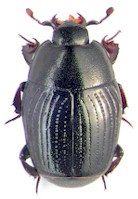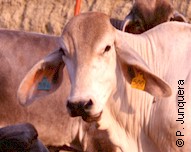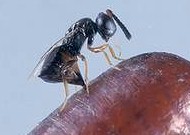What is Integrated Pest Management?
Integrated Pest Managemnt (=IPM), also known as Integrated Pest Control, consists basically in applying all measures available for controlling a parasite population avoiding to rely only on chemical antiparasitics.
The FAO defines IPM as "the careful consideration of all available pest control techniques and subsequent integration of appropriate measures that discourage the development of pest populations and keep pesticides and other interventions to levels that are economically justified and reduce or minimize risks to human health and the environment."

In general, independently from resistance development, IPM makes it possible to reduce the amount of chemicals used in a property, which reduces the contamination of the environment with chemicals as well as the exposure of workers and livestock to such chemicals, and the costs of antiparasitics and equipment.
In addition to these benefits, it must be said again and again that it is urgent to rely more on IPM in order to prevent or at least reduce the development of resistance, particularly by those parasites that already have developed a serious resistance problem (e.g. cattle ticks, horn and buffalo flies, houseflies, blowflies, sheep lice, red fowl mites, gastrointestinal roundworms, liver flukes). Urgency is also due to the fact that for most animal health companies it has become too expensive to invest in discovering and developing really new products, i.e. with a new mechanism of action, and have given up trying it. This means that those products still available have to be used in a manner that does not encourage resistance development and allows to keep them effective for as long as possible.
For these reasons, and wherever possible, on top of introducing chemical control practices that delay resistance development (e.g. product rotation, adequate use of mixtures, etc.), it is essential to use whatever non-chemical tools are available. Even if they do not provide sufficient control when used alone, together with targeted chemical control they can do the job while reducing the risk of resistance development because most non-chemical tools do not exert selection pressure, or they do it in a completely different way as chemicals do.
IPM applied to livestock includes structural and management measures in a property to be combined with biological, mechanical and chemical tools. Such structural and management tools as well as some non-chemical control alternatives are described below. For more details visit the article on each specific parasite in this site.
Structural and management tools to help controlling parasites
Constructive measures. Design and build the facilities (poultry houses, pigsties, milking parlours, etc.) in a way that typical parasites in such facilities (e.g. red fowl mites, fly larvae, fleas, etc.) do not find hiding places that are difficult to clean or to treat (hollow tubing; double floors, walls or ceilings; drains with difficult access, etc.). Ensure that facilities are well ventilated (humidity favors numerous parasites), etc.

Livestock management. This includes the use of breeds that have been selected for their resistance to specific parasites that are a problem in the region (e.g. cebu cattle or crosses that are naturally resistant to ticks; sheep breeds that are more tolerant of gastrointestinal worms, etc.), or that are particularly well adapted to local ecological conditions (climate, food, etc.). A highly productive breed in an ideal european environment (e.g. Holstein dairy cattle) exposed to an unfavorable environment as in the tropics may be under permanent stress, which will make it weaker and thus more susceptible and vulnerable to parasite infestations.
Livestock health. It must be ensured that livestock is always in good health conditions and well fed to activate its own natural defenses against parasites. This is particularly important in periods that are hard for the animals (drought, cold and rainy weather, etc.) and during the season when the parasites are known to be more abundant. Even carrying parasites, a healthy animal may tolerate them without a productive loss if it is fit. In this context avoiding excessive stocking rates is quite important to ensure that the animals are well fed.
Pasture management. Pasture rotation, pasture burning, drainage, ploughing, etc. may contribute to reduce the population of some parasites (e.g. cattle ticks, horn and buffalo flies, gastrointestinal roundworms, etc.) to some extent. It will certainly not eliminate them but is equally effective against susceptible and resistant parasites.
Hygiene. All measures that ensure the elimination of organic waste (carcasses, garbage, remains of food, milk and eggs, etc.), the correct management of manure, and the elimination of useless water points (stagnant ponds and pools; drums, cans and tires filled with water; leaking pipes and gutters, etc.) are essential to reduce the breeding points of numerous flies and mosquito species.
Keeping the pastures as dry as possible by improving drainage and avoiding floodings reduces the survival of the free-living stages of gastrointestinal roundworms and of intermediate hosts for many helminths, thus preventing the build-up of large free-living parasite populations.
More specific preventative measures are described in the articles on specific parasites in this site.
Biological, mechanical or non-synthetical chemical control of parasites
Natural enemies. Avoid whatever can harm the natural enemies of the parasites. This is particularly relevant in manure management (poultry swine, dairy) in order to enable natural predators of fly larvae to remain active. Such natural enemies won't eliminate the flies, but they will reduce the populations to some extent.

Biológical control. If available, it is highly recommended to use biological control tools such as beneficial insects, insecticidal or nematicidal fungi, etc. They are mostly natural enemies of the parasites that can be
produced industrially and are released in the field where they may be already present but not in such quantities to significantly affect the parasite populations. Such natural enemies will not eliminate the parasites, but may keep them below the economic damage threshold, particularly in confined operations (e.g. dairy farms, poultry houses, etc.). You can visit the specific section on biological control on this site.
Vaccines. There are extremely few vaccines against livestock parasites, but the use of those available can make sense, e.g. the cattle tick vaccine in dairy operations. Some vaccines against Haemonchus for sheep are also available. Read the article on vaccines against livestock parasites in this site.
Mechanical control. It can be quite effective in the form of traps (mechanical, electrical, etc.), commercial or self-made ones, particularly against houseflies and stable flies. It could also be implemented against horn flies, e.g. letting the animals walk through a range equipped with a simple device (e.g. a curtain) that makes the flies fly away from the animal's body to be aspired by a strong vacuum aspirator. In some properties it may be possible to periodically destroy cow pads on pasture with a tractor: several fly species (e.g. horn flies, face flies) need intact cowpads for breeding. There are also useful traps against sheep blowflies.
Non-synthetical parasiticides. There are a few mineral products that can be useful for the control of some parasites: e.g. silica against sheep lice or red fowl mites; copper against certain gastrointestinal roundworms. Such products are usually insufficient, but can make a lot of sense in particular properties in the context of IPM
Medicinal plants and natural insecticides. There are numberless traditional methods based on medicinal plants that are used with different success in many regions. They are mostly used in traditional low-scale farming and usually they are not adequate for industrial production and large-scale livestock operations, but they can make sense in particular situations. More information is available in the article on medicinal plants on this site. There are also several natural insecticides that are used mainly in small animal antiparasitics. They are almost never appropriate for livestock but may help to solve particular problems.
Strategic usage of antiparasitics
Strategic usage of antiparasitics means to apply them in a way that optimises its impact on the parasite population and/or minimises superfluous product usage.
In the article in this site on cattle ticks it has been already explained what is meant by strategic treatment for such parasites. Summarising, strategic treatment for such ticks consists in treating the animals more intensively at the beginning and at the end of the tick season. At the beginning, when the tick population is still rather low, to reduce its multiplication. And at the end, to ensure that less ticks survive that will overwinter. This apllies basically to any parasite with a seasonal development: treat more intensively at the beginning and at the end of the season. This is in contrast with the often observed "opportunistic approach" of intensifying treatments along the season as the parasite population increases, i.e. you treat more when you see more parasites. The problem with this approach is that, regarding the whole population in a property (i.e. both on and off the animals), opportunistic treatments come usually too late and have little impact on the off-animal parasite population.
A way to minimise superfluous usage is to treat the animals only when the number of parasites exceeds the economic damage threshold. In fact, it makes little sense to treat animals if the cost of product and treatment is higher than the additional benefit of getting rid of the parasites for a certain period of time.
Both cases mean that there are periods of time with fewer chemical treatments. During such periods non-chemical control tools can be implemented. In any case, both approaches reduce the number of treatments and thus the selection pressure on the parasite population, which is the major target of IPM.
In the case of anthelmintics there are several options for achieving this goal. One option is to reduce the number of treatments in animals that are less likely to suffer from worm infections (often the adults), while concentrating treatment on those that are usually more susceptible (often young animals). Other options are based on the sequential use of pastures by different groups of animals in the property. More specific recommendations depend on the ecological conditions, on purpose (dairy, breeding, fattening, etc.), on management practices, etc. Ask your veterinary doctor or an extension officer for more specific recommendations.
Regarding worm control, more specific information can be found in the article on Prevention & Control of Gastrointestinal Roundworms in this site.
Links to other articles on resistance in this site: